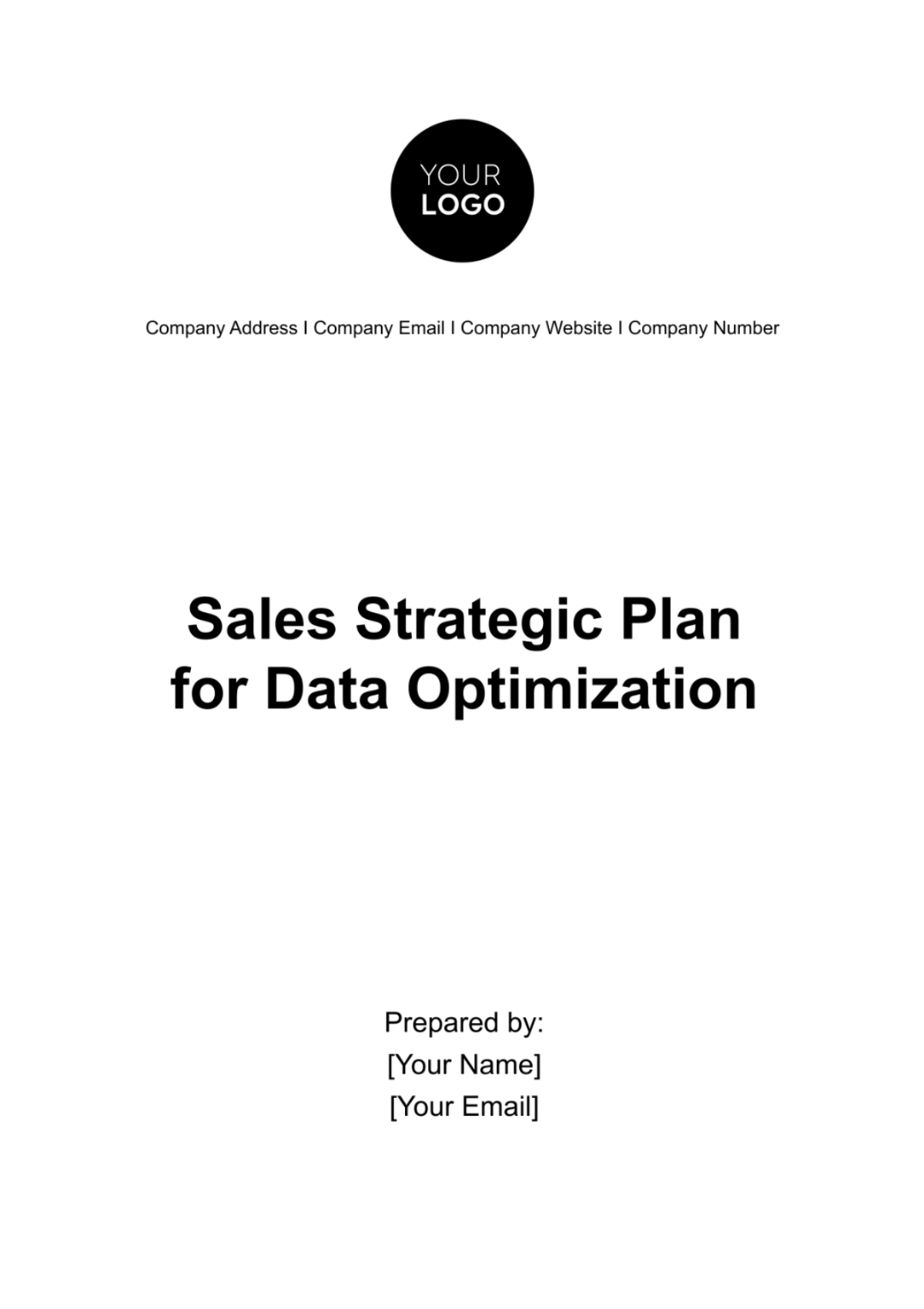Free Sales Strategic Plan for Data Optimization

I. Introduction to Data Optimization in Sales
In today's hypercompetitive business environment, controlling the power of data has become a given for any company who’s looking to succeed within the world of sales and marketing! Gone are the days of running a business by instinct, driving your company’s decision making process shall now be influenced mostly by gathered data, allowing you to make informed choices, wherein your strategy and tactics will be properly formed.
Data allows a company and its assets to make proper moves. Enterprises that know how to utilize data are most likely to outperform their competitors and develop in the ever-growing digital age. A recent study was conducted by varying sources in the year of [20xx] that revealed that data-driven companies have a [Percentage] increased chance of acquiring new customers, a [Percentage] increase in retaining those said customers, and a [Percentage] increase in profits. This plan emphasizes just how critical data optimization is when it comes to sales.
As we map out our strategic plan, we will explore the various methods of data optimization in sales, inquire about the different strategic tools and ideas we can use that can help empower [Your Company Name] and unlock its full potential within the sales industry. From real-time customer engagement to reflective analysis of past projections, we will cover the many key avenues that can lead to revenue growth and enhanced customer satisfaction.
II. Data Assessment and Inventory
As we delve into the potential of data optimization, the very first step [Your Company Name] has to take is fully comprehending its already existing data resources. This step, under the broader framework of data optimization, is crucial for evaluating the current state of our data and creating a structured data inventory. This groundwork is essential, as it not only prepares the stage for successive data-driven strategies, but also ensures that our plans are structured on a solid foundation.
Current State Analysis
With the goal of data optimization in mind, [Your Company Name] will start with an in-depth analysis of the current state of our data. Meticulous examination of the quality and certainty of our data will be crucial in the phase; Analyzing each and every data source for any existing inconsistencies or gaps will help in recognizing these errors in the future, assisting in making sure that our data structure becomes dynamic and reliable.
Failing to do this will put [Your Company Name] at risk of building strategies and tactics on a shaky foundation, which may lead us to making faulty decisions and flawed processes.
Data Inventory
As we maximize the benefits of data, it is essential to take full note of our data assets with full understanding. This is where the concept of a data inventory comes into play, in which we can categorize our data by type and category. We classify data into segments such as customer data, sales data, market data, etc. This categorization will provide us with a clearer map of the diverse data assets at our disposal.
In the next steps of our data optimization plan, we will erect a sturdy structure of information processing based on the foundational report gathered by the data inventory. Now that we have a clearer understanding of our company’s strengths and weaknesses, we must dive deeper into the field of data enhancement, analytics, and strategic application.
III. Data Collection and Integration Strategy
This strategic phase is where we lay the proper groundwork for gathering and adjusting data from various sources. It all starts with a clear understanding of our goals and the seamless integration of data into all of our sales systems.
Defining Data Collection Goals
Our venture toward data optimization begins with a detailed set of data collection goals. These goals will serve as our beacon for which specific data need to be collected and why these data need collecting. In order to gather these data effectively, we must identify and articulate our data collection objectives; This includes pinpointing the key performance indicators (KPIs) and metrics that align seamlessly with our sales objectives.
Consider this phase as creating the blueprint for our data collection efforts. It's not about gathering data indiscriminately, but rather precision, in that we can ensure that every piece of data we collect serves a purpose and contributes to our overall strategy.
Integration with Sales Systems
Data integration is essential for achieving real-time insights and maximizing the value of all of our data. In this phase, we will focus on seamlessly integrating our data sources, with a particular emphasis on key systems such as Customer Relationship Management (CRM) and Enterprise Resource Planning (ERP). This integration ensures that our sales teams will have access to up-to-date information, giving them the power to make informed decisions and respond swiftly to any market dynamics.
Without proper integration, we risk encountering disjointed and fragmented data, hindering our ability to see the bigger picture and make strategic choices effectively.
In the next few phases of our data optimization plan, we will be equipped with clearly defined data collection goals, and a seamless data integration framework. We will explore the realms of data analysis, data interpretation, and actionable insights.
IV. Data Analysis and Insights
The process of data analysis and deriving actionable insights is the crucible where raw data is transformed into the gold of informed decision-making. This section is dedicated to unveiling the strategies and techniques we will employ to maximize the value of our data through analysis, the identification of key metrics and KPIs, and effective data visualization.
Analytical Tools and Technologies
In this phase, we make a strategic investment in cutting-edge analytics solutions that have the capacity to efficiently process large datasets. These tools serve as the engines that power our data-driven insights, enabling us to uncover trends, correlations, and patterns hidden within the vast expanse of our data.
The value of data lies not only in its possession but also in the ability to control its potential effectively. Simply having data emerges when there are tools, insights, and strategies in place to extract meaningful information, drive informed decisions, and unlock the full value inherent in these data.
Key Metrics and KPIs
Identifying the right metrics and Key Performance Indicators (KPIs) is the guide that our data-driven venture needs in order to measure our progress. This section is dedicated to the careful selection and definition of these crucial indicators. We set performance benchmarks that not only quantify our success but also align with our predetermined goals.
Our chosen metrics will serve as our guide, in order to ease through the complex fields of the business landscape. By relying on carefully selected performance indicators, we aim to navigate challenges, make informed decisions, and steer the organization toward sustained success and growth.
Data Visualization
The ability to turn complex data into easily digestible insights is pivotal for effective decision-making. This is where data visualization takes center stage. In this phase, we focus on creating intuitive dashboards and reports that transform our raw data into visual representations. These visualizations are designed to be accessible to all team members, ensuring that insights are not confined to a select few but are readily available to inform actions across our sales teams.
We will continue to build upon the foundation laid here. Equipped with cutting-edge analytics tools, well-defined metrics, and effective data visualization, [Your Company Name] and its teams will delve deeper into the realms of predictive analytics, real-time insights, and personalized customer engagement.
V. Data Security and Compliance
This section addresses our comprehensive approach to data security and our dedication to complying with stringent data regulations. The objective is twofold: to ensure the protection of sensitive information and to uphold the trust of our customers while aligning with industry standards and legal requirements.
Data Security Measures
Our commitment to data security is non-negotiable: to fortify the digital security that protects our data, we will implement a strong array of security measures. Among these measures, data encryption will stand as a formidable shield, rendering our data inaccessible to unauthorized entities. Access controls and authorization processes will act as vigilant gatekeepers, ensuring that only those with the proper clearance can enter the data system.
The reasoning is evident: safeguarding data goes beyond fulfilling legal and ethical obligations; it stands as a foundational element upon which customer trust and the reputation of the business are constructed. Recognizing the critical role of data security is essential not only for compliance but also for establishing and maintaining a robust relationship with customers and safeguarding the integrity of the business in the long run.
Compliance with Data Regulations
Adhering to data regulations is a prerequisite for ethical business conduct. We’ve pledged to uphold the stringent standards set forth by regulations such as the General Data Protection Regulation (GDPR) and the California Consumer Privacy Act (CCPA). These regulations are not merely legal hurdles; they are ethical compasses that guide our actions in safeguarding customer privacy.
Regular audits will be conducted to ensure ongoing compliance with these data regulations. By continuously aligning our data handling procedures with these regulations, we demonstrate our unwavering commitment to ethical data management and customer trust.
VI. Conclusion and Implementation
It's essential for [Your Company Name] to recap the key takeaways and outline the steps for seamless implementation. This strategic plan, rooted in the power of data, serves as the blueprint for elevating sales performance, enhancing customer satisfaction, and gaining a competitive edge.
Recap of Key Takeaways
As a recap, this strategic plan underscores the pivotal role of data in reshaping the landscape of sales. It emphasizes the necessity of data optimization as a strategic imperative for our organization. Key takeaways include:
The significance of data assessment and inventory.
The critical importance of data collection and integration.
The art of data analysis and deriving actionable insights.
The non-negotiable commitment to data security and compliance.
Action Plan for Implementation
Turning vision into reality requires a well-structured action plan. In the forthcoming phase, we will assign specific responsibilities to dedicated teams within our organization. Clear timelines will be established for each data optimization initiative, ensuring that our strategic plan transforms into tangible results. Our structured approach ensures that our plan properly comes to fruition.
Monitoring and Continuous Improvement
Our commitment to data optimization is not a one-time endeavor but an ongoing journey. Post-implementation, we will continuously monitor and improve upon any data discoveries. We will closely track the performance of our data initiatives, gather feedback from teams and stakeholders, and make iterative enhancements to our strategy. This dynamic approach ensures that we remain agile and responsive to changing market conditions.
By adhering to this Sales Strategic Plan for Data Optimization, [Your Company Name] is poised to unlock the full potential of its data assets. This endeavor will fuel growth and success in the sales department and ripple out to impact the entire organization.
- 100% Customizable, free editor
- Access 1 Million+ Templates, photo’s & graphics
- Download or share as a template
- Click and replace photos, graphics, text, backgrounds
- Resize, crop, AI write & more
- Access advanced editor
Revamp your sales strategy with Template.net's Sales Strategic Plan for Data Optimization Template. Unleash the power of data to drive growth. This customizable and editable template with the help of our Ai Editor Tool guides you to create step-by-step to harness insights, maximize ROI, and boost sales. Elevate your business today with this invaluable resource. Sign up for any of our subscription plans today.





























